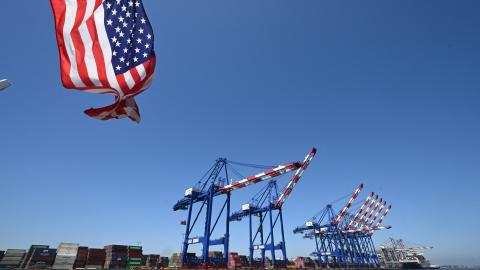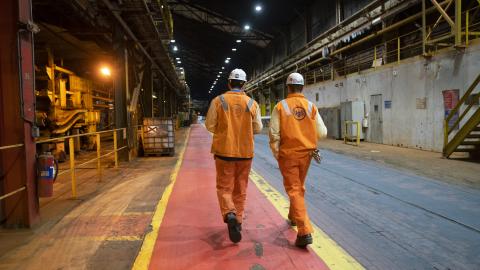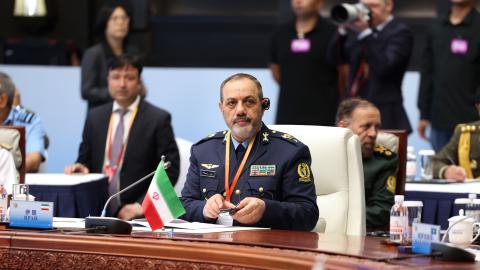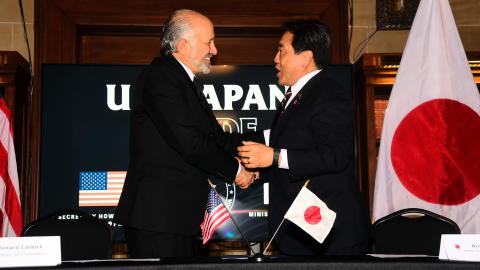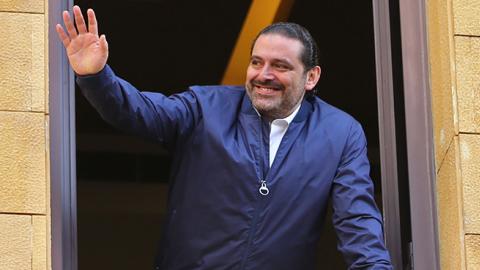Donald Trump may have divided America, destroyed the mainstream of the Democratic Party and split the GOP, but he’s unifying the Middle East. Or at least Iran. According to The New York Times’ man in Tehran, Thomas Erdbrink, Trump has whipped Iranians of every class, ethnicity, and political tendency into a nationalist fervor.
“Iranians listened during the 2016 campaign as Mr. Trump denounced the Iran nuclear treaty as ‘the worst deal ever negotiated’ and promised to tear it up,” writes Erdbrink. “They watched in horror when, as president, he sold more than $100 billion worth of weapons to the kingdom of Saudi Arabia and participated in a traditional war dance in Riyadh.” Trump’s partner in uniting Iranians behind their leadership, the Times explains, is “the young Saudi crown prince, Mohammed bin Salman, whom [Iranians] see as hotheaded and inexperienced.”
What’s weird is that Trump and the man known as MBS pulled off the same trick in the eastern Mediterranean just two weeks ago. After Lebanese Prime Minister Saad Hariri was summoned to Riyadh, where some say he was kidnapped and resigned the premiership, a fractious Lebanese polity rallied as one, demanding the return of their beloved leader. Pictures of Saad decorated the length of the airport road—a thoroughfare running through an area controlled by Hezbollah, which is accused of having killed Hariri’s father, Rafik, with a car bomb in 2005.
So, have Trump and the Saudis “fanned the flames of war,” as Beirut-based reporter Thanassis Cambanis wrote in The Atlantic? Do their actions threaten to “shatter the Lebanese mirror,” as former Obama deputy Robert Malley wrote, also in TheAtlantic? As another former Obama administration aide, Ilan Goldenberg, tweeted, “Launching a major new war in one of the few countries in the Mideast that had been stable over the past few years would be the height of folly.”
But before you trust the chorus coming from The Atlantic, the Times, and Twitter: Hasn’t Iran been sending weapons and proxy armies for the past several years to fan the flames of war in Iraq, Syria, and Yemen? As for “destabilizing” Lebanon, isn’t Hezbollah the source of that country’s chronic instability? It’s hard to imagine stability in any country that is controlled by a terrorist group that insists on war against its two larger neighbors, Israel and Syria’s Sunni community.
What’s unfolding here is an information campaign designed to protect the pro-Iran policies of the Obama administration. These include preserving the Joint Comprehensive Plan of Action, realignment with the Islamic Republic, and acquiescence to Iran’s accumulation of real estate as it completes its so-called land bridge reaching from the Persian Gulf to the borders of American allies Israel and Jordan.
What worries Obama operatives aren’t the details they are busy spinning, but the big picture: Trump is leaning toward traditional American allies, Israel and Saudi Arabia, and may be inclined to pull out of the nuclear deal—which is the support structure for realigning the United States with Iran. If Trump pulls the plug, then Obama’s “legacy” in the Middle East collapses. That’s why all of the former president’s foreign-policy hands are on deck.
A more interesting question is: How did Lebanon become so central to this effort? The answer is that Beirut is the birthplace of the Western media’s pro-Iran echo chamber, and is now the key junction between Obama’s coterie in Washington and their Iranian partners.
Once referred to as the Paris of the Middle East, the Lebanese capital became ground-zero in the mid-1970s for a regional conflict that gave Western journalists front-row seats while the standard-bearers of the international left, Yasser Arafat and the Palestine Liberation Organization, took the fight to the entrenched forces of reactionary injustice. The Western media frequently took sides in that conflict. That American journalists began referring to the Jewish state to the south as “Dixie” around this time gives you a pretty good idea where their sympathies lay.
When the press’ home team was forcibly relocated from Beirut to Tunisia in 1982, a new champion announced itself with a series of spectacular operations that in 1983 alone targeted, among other sites, the American embassy in Lebanon, killing 63 people, including 17 Americans, and the U.S. Marine barracks in a massive suicide bombing that claimed 241 American lives. The Party of God, or Hezbollah, had captured the world’s attention, and its legend grew as it dispatched more and more Shia youths to detonate bombs.
The hagiography holds that Hezbollah, composed of pious and impoverished young Shiites, a community long held in contempt by the rest of Lebanese society, especially the wealthy Sunni merchants and the “right-wing” Christians, arose out of the indignity of the Israeli occupation in 1982. Their goal was to liberate the country and restore honor and pride to all Lebanon. Indeed, the Western press still peddles this story. In fact, Hezbollah arose out of a split between two Iranian factions of the anti-Shah opposition that was training in Lebanon in the early 1970s.
As Tablet colleague Tony Badran explained several years ago in an important article, one side of the anti-Shah opposition was aligned with the Iranian-born cleric Moussa Sadr, who since moving to Lebanon had become a major figure in Beirut politics, forming the movement of the dispossessed, or AMAL. The other group feared that the charismatic Sadr could not be trusted to advance their revolutionary goals and might even pose a threat to their leader, exiled in Iraq and later Paris, Ruhollah Khomeini. The Khomeinists eventually routed their opponents, in Iran as well as Lebanon, where they remade a group of Shia militants, many of them trained by the PLO, in their own image. They even gave them the same name by which they were known: Hezbollah.
Did the Western press not know that Hezbollah was an Iranian clone from the outset and its genesis pre-dated the Israeli occupation by nearly a decade? My guess is that they were largely incurious about the organization they’d flocked to Lebanon to cover. Asking too many questions was also unwise, given Hezbollah’s record in kidnapping and torturing American intelligence operatives and journalists. In any case, Hezbollah and the Iranians quickly understood that the Western press was a useful and pliant mechanism to broadcast their propaganda. The combination of fear, ignorance, and laziness on the part of the Western press meant that the Iranians were free to make up whatever stories about themselves that they wanted.
The mid-1990s saw the origins of the narrative holding that Hezbollah had gone through a transformation; a “Lebanonization,” if you will. The group that used to kidnap and torture American intelligence officials, take journalists hostage, and liquidate opponents in Europe was no more. In its place now stood an authentically Lebanese entity, which featured both a “political wing” and a “military wing.” Moreover, contrary to the simplistic analysis of Israeli and American right-wing officials, even the “military wing” of Hezbollah in fact operated independently from Iran.
The Lebanonization thesis laundered Iran’s activities at a key moment. Then Iranian president Mohammed Khatami was promoting the dialogue of civilizations, an initiative that surely promised an opening to the West. American policymakers had a stake in introducing all manner of nuance and differentiation when addressing Iran’s relationship with Hezbollah.
After the Sept. 11 attacks, the Lebanonization narrative helped keep Hezbollah out of the war on terror’s crosshairs. Al-Qaida is a transnational terror outfit that kills Americans, but Hezbollah, according to this new gospel of convenience, was nothing like that at all. It was a national resistance organization, which only continued to bear arms against the threat of another Israeli occupation, and was meanwhile ever more involved in the mundane business of Lebanese politics.
The Obama administration’s realignment of American interests away from traditional regional partners Israel and Saudi Arabia and toward Iran made Hezbollah’s “legitimacy” an even more important article of faith—and Beirut an even more important center for coordinating information operations.
Here’s how the current Beirut-based campaign started: In his Washington Post column, David Ignatius tied the Saudi crown prince’s anti-corruption purge in Saudi Arabia to a visit from Trump adviser and son-in-law Jared Kushner. Because Saad Hariri was called to Riyadh during the detentions, the echo chamber contended, the Trump administration must be trying to force a confrontation with Iran in Lebanon, using Kushner as its dark instrument.
While the central importance of Jared Kushner would appear to be a giggle-worthy invention, it’s not unreasonable to think that Hariri was, in fact, swept up as part of the anti-corruption campaign. Several of the Saudi figures detained at the Ritz in Riyadh were past allies of his. Yet contrary to most reports, he has not been Saudi Arabia’s man in Lebanon for several years. The Saudis had tried to discourage him from taking the job of prime minister last year, but because they weren’t paying him anymore they had little say over his decisions. Hariri was broke, and he saw the premiership as a way to make money. Thus, he became Iran’s Sunni in Lebanon.
Hariri’s political partnership with Hezbollah and its allies aimed to put him in position to tap several promising ventures, for instance, reconstruction aid for Syria, which, Hariri is betting, Europe and China are eager to start funding. Further, there are potential offshore oil ventures and other prospects—all of which would mean billions going through the Lebanese government Hariri heads.
Saad Hariri’s cousin, Nader Hariri, is the point man for this grand partnership with Hezbollah ally President Michel Aoun, and, especially, with his son-in-law, Foreign Minister Gebran Bassil. Nader has a lot at stake in his cousin keeping his job—either he or someone in his immediate circle started leaking to Lebanon’s pro-Hezbollah media about the Saudis as a “destabilizing force.” According to sources in Lebanon, that was also the origin for David Ignatius’s follow-up article on the Saudis “virtual kidnapping” of the prime minister.
The point was to change the subject—now the story is not about Hezbollah and the Hariris using their ostensible role as Saudi allies to provide cover for Iranian control of Lebanon. No, no, put it on the Saudis. Iran hasn’t taken a country hostage—as Ignatius wrote, the Saudis kidnapped a prime minister!
This played well in the local arena. It’s hard not to feel sympathy for the Lebanese who indeed have little ability to rescue themselves from the middle of a dangerous and potentially explosive regional dynamic. But the episode showed their ugly side, too. For years Saudi Arabia has invested billions of dollars in Lebanon, and everyone, including the Shiite community, has profited, while Riyadh got little for its investment. With Hezbollah running the show, Lebanon was less a victim of regional instability than a source of it—sending its fighters to Syria, and training Iranian proxies in Iraq and Yemen, which threatened Saudi national security directly. Plus there was always the likelihood of renewed hostilities between Hezbollah and Israel.
While one can see why the Lebanese would not be keen to challenge the organization that controls the country through force of arms, it also seems fair for the Saudis to decide they don’t have to keep paying just because the Lebanese want them to. Saudi Arabia just cut up the credit cards and Lebanon acted out. If you don’t pay us, you’re destabilizing Lebanon!
That message resonated with the Beirut-based Western press corps and local social media activists. But the reason tiny Lebanon roared so loudly is because the Beirut-based echo chamber was supported by the communications expertise and media platforms of Obamaworld back in Washington. So Robert Malley filed for the Atlantic from Beirut, explaining the sources of instability in Lebanon and the region within the frame in which those details mattered back home: “the Trump administration calling into question the Iranian nuclear deal and considering ramping up sanctions against Tehran, which unnecessarily heightens tensions, coupled with the absence of the kind of regular, high-level contact between the two countries that could de-escalate them.”
The Obama administration’s former ambassador to Israel, Dan Shapiro, now living in Israel, tailored his argument for the local audience. In Haaretz, Shapiro dismissedthe Netanyahu government’s cautious enthusiasm for Israel’s growing relationship with Saudi Arabia. Riyadh’s no friend, argued Shapiro—rather “it is plausible that the Saudis are trying to create the context for a different means of contesting Iran in Lebanon: an Israeli-Hezbollah war.” It was a strangely familiar conceit, with a novel twist—Saudi wants to send Israeli boys to fight and die in Saudi wars. Amos Harel picked up the same theme, again in Haaretz, where he quoted Shapiro’s article. The information campaign’s essential takeaway was that Obama was right to go with Tehran over Riyadh. And now that fool Trump is going to blow it apart!
The peculiar twist here is that unlike the Saudis, in practice Trump doesn’t seem to have much of a problem with Iranian control of Lebanon. His administration is continuing to fund the Lebanese Armed Forces, which is at this stage little but a Hezbollah auxiliary, covering the Party of God’s flank and providing logistical support for its war in Syria. But it’s the big picture that has the echo chamber worried.
